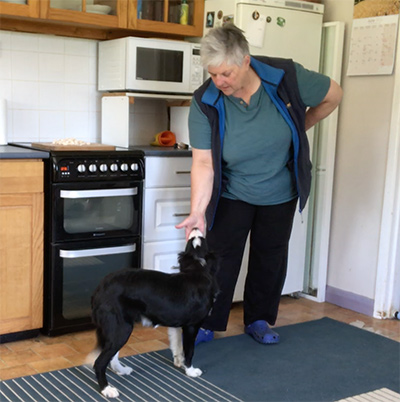Practise: Breakfast in Bed
Many experienced dog trainers will advise you to invest in your practise time, rehearsing without the dog is one of the best investments of your time.
This time is the chance to go through it slowly, be sure you have everything ready and in place. You can repeat, change, adapt, be sure what you are doing and gain confidence.
Once your dog is in the picture they will have plenty to say about what you are doing and offer lots of advice – such as hurry up! Feed me now!
Practise first without the dog
You need:
- A small bowl of something treat sized to practice with. It can be dried beans, coins, Lego blocks or the dog’s food
- 1 sticky note
- A vertical surface (wall, door or cupboard)
- A table within reaching distance on which to place the bowl of practise food
- 5 minutes of uninterrupted time without your dog (put him in another room)
Process:
- Determine your dog’s muzzle height when the head is held comfortably level
- Attach a sticky note to a flat vertical surface at that height
- Put your bowl of practice “food” on a table beside you
- Take a bean from the bowl with one hand, pass it into the other and move the feeding hand to directly in front of the sticky note. Do not touch the sticky note. Hold the bean in a softly cupped relaxed hand
- Do 10 repetitions with each hand.
- If you have a small dog, bend your knees!
Repeat until you can find the correct placement consistently and without conscious effort
Love that face!
Include plenty of time to give your dog a chance to see an open hand as an opportunity to sniff, or have a quick brush of their muzzle.
We want to teach the dogs, especially puppies that hands are something to seek information from, approach without anxiety and on many occasions enjoy affection.

Knowledge & Understanding
Skills &
Competency
Measuring competency
Stage 1 – Unconsciously unskilled
We don’t know what we don’t know. We are inept and unaware of it.
This is where we all begin. As a trainer the recipe instructs minimally as “treat”. We now look at this and realise delivering a treat is a skill. There are many considerations and motor patterns to practise and develop.
Stage 2 – Consciously unskilled
We know what we don’t know. We start to learn at this level when sudden awareness of how poorly we do something shows us how much we need to learn.
As we progress in our training, we may return to this stage many times as we become aware of skipping pass a skill.
Stage 3 – Consciously skilled
Trying the skill out, experimenting, practising. We now know how to do the skill the right way, but need to think and work hard to do it.
This is where the really hard work sets in. We may need to step away, re-learn our skills, self-checking our progress. Seeking feedback and working past the errors and future-less habits that came from skipping this stage when we first began.
Stage 4 – Unconsciously skilled.
If we continue to practice and apply the new skills, eventually we arrive at a stage where they become easier, and given time, even natural.
This is heaven. This is where we find the flow and rhythm in teaching. This is where it seems natural and unforced, where our confidence comes through and we can lay down a learning pathway that brings pleasure and joy to learner and teacher.
Learn:
Application & Activities
Teach:
More questions?
shared learning grows the whole community……
Comment?
Comments made in this section are only on view to other Setter Members. Ask for more details, more clarity or share a relevant link.
Community
When people with the same passion get together learning explodes. Many of us are travelling the same path, with the same doubts, the same desires to learn more.
More ?
Where would you like to go? What piques your interest? Would a Micro-Lesson help you understanding and improve application?
